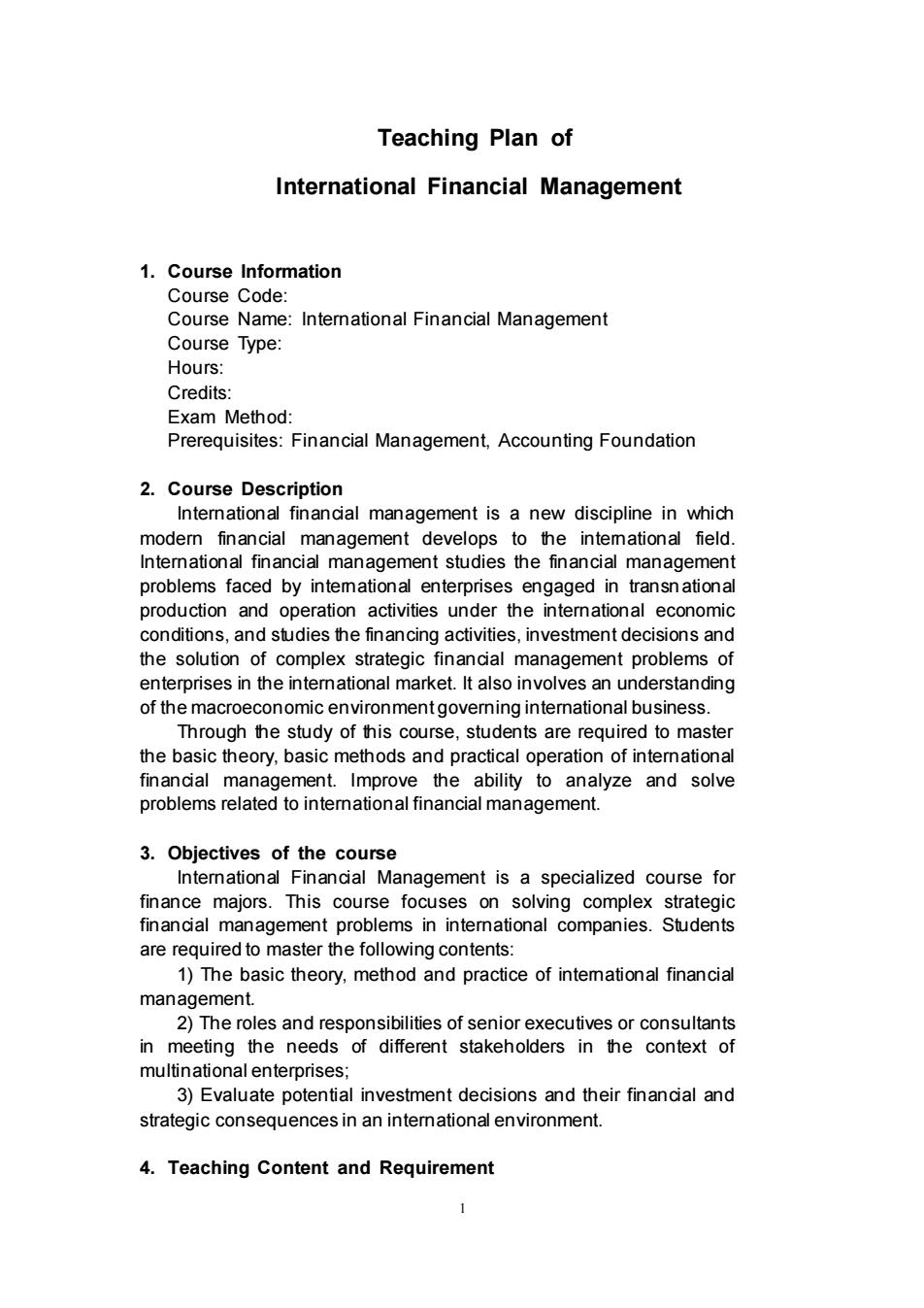
Teaching Plan of International Financial Management 1.Course Information Course Code: Course Name:Intemational Financial Management Course Type: Hours: Credits: Exam Method: Prerequisites:Financial Management,Accounting Foundation 2.Course Description International financial management is a new discipline in which fina ial management de velo the intemational field. Intemational financial management studies the financial managemen problems faced by intemational enterprises engaged in transn ational production and operation activities under the intemnational economic conditions.and studies the financing activities,investment decisions and the solution of comp plex strategic financial man gement problems of enterprises in the intemational market.It also involves an understanding of the macroeconomic environment goveming international business. Through the study of this course,students are required to master the basic theory,basic methods and practical operation of intemational financial management.Improve the ability to analyze and solve problems related to intemational financial management 3.Objectives of the course International Financial Management is a specialized course for finance majors.This course focuses on solving complex strategic financial management problems in inter ational companies.Studer ts are required to master the following contents 1)The basic theory,method and practice of intemational financial management. 2)The roles and responsibilities of senior executives or consultants in meeting the needs of different stakeholders in the context of multinatio nal enterprises 3)Evaluate potential investment decisions and their financial and strategic consequences in an international environment. 4.Teaching Content and Requirement
1 Teaching Plan of International Financial Management 1. Course Information Course Code: Course Name: International Financial Management Course Type: Hours: Credits: Exam Method: Prerequisites: Financial Management, Accounting Foundation 2. Course Description International financial management is a new discipline in which modern financial management develops to the international field. International financial management studies the financial management problems faced by international enterprises engaged in transnational production and operation activities under the international economic conditions, and studies the financing activities, investment decisions and the solution of complex strategic financial management problems of enterprises in the international market. It also involves an understanding of the macroeconomic environment governing international business. Through the study of this course, students are required to master the basic theory, basic methods and practical operation of international financial management. Improve the ability to analyze and solve problems related to international financial management. 3. Objectives of the course International Financial Management is a specialized course for finance majors. This course focuses on solving complex strategic financial management problems in international companies. Students are required to master the following contents: 1) The basic theory, method and practice of international financial management. 2) The roles and responsibilities of senior executives or consultants in meeting the needs of different stakeholders in the context of multinational enterprises; 3) Evaluate potential investment decisions and their financial and strategic consequences in an international environment. 4. Teaching Content and Requirement

Part 1 Foundations of International Financial Management ves and req irements 1)Unde standing and mastering the development of transn ationa corporations and the importance of intemnational financial management 2)Understandina and masterina the evolution of the international monetary system and the European monetary system g and Mas ring Balance of Payments Statement and B nce of Payments Theory b.Content Section One: Chapter 1 Globalization and the Multinational Firm 1)Main Content his section introduces the general situation of intemational finandal management. expounds the importance of intemnational financial research,and distinguishes the differences between intemational finance and domestic finance 2)Basic concepts and key points The characteristics of international financial management,the objectives of international financial management,Main Trends and Development of World Economic Globalization 3)Questions application differences between intemationa finance and domestic finance,understand and maste the main trends and development of world economic on the basis of understanding the intemational background Why is it important to study intemational financial management? How is international financial management different from domestic financial management?Discuss the maior trends that have iled in inte usiness during the st two How is a country s economic well- eing enhanced through free intemational trade in goods and services? Section Two: Chapter 2 International Monetary System 1)Main Content This section introduces various intemational monetary systems in which the world economy operates
2 Part 1 Foundations of International Financial Management a. Objectives and requirements 1) Understanding and mastering the development of transnational corporations and the importance of international financial management 2) Understanding and mastering the evolution of the international monetary system and the European monetary system 3) Understanding and Mastering Balance of Payments Statement and Balance of Payments Theory b. Content Section One: Chapter 1 Globalization and the Multinational Firm 1) Main Content This section introduces the general situation of international financial management, expounds the importance of international financial research, and distinguishes the differences between international finance and domestic finance. 2) Basic concepts and key points The characteristics of international financial management, the objectives of international financial management, Main Trends and Development of World Economic Globalization 3) Questions and application Understand the differences between international finance and domestic finance,understand and master the main trends and development of world economic globalization, and grasp the international financial management objectives of different countries on the basis of understanding the international background. Why is it important to study international financial management? How is international financial management different from domestic financial management? Discuss the major trends that have prevailed in international business during the last two decades. How is a country’s economic well-being enhanced through free international trade in goods and services? Section Two: Chapter 2 International Monetary System 1) Main Content This section introduces various international monetary systems in which the world economy operates

in different periods.This section traces the historical development the world's ational monetary system from the beginning of the 19th century to the present,as well as the European Monetary Union. 2)Basic concepts and key points Evolution of International Monetary System Monetary System. Rate Arrangement European Monetary System,E uro and European Monetary Union,Mexican Peso Cri sis,Asiar Currency Crisis,Argentine Peso Crisis,Fixed Exchange Rate System and Elastic Exchange Rate System 3)Questions and application Underst ding the evolution of the intemational monetary system,mastering the arrangement of the current exchange rate system,explaining how to construct SDR,and explaining the arrangement and operation of the European Monetary System(EMS). Explain mechar balance-of-payment under the gold standard. Discuss the advantages and disadvantages of the gold standard. What were the main objectives of the Bretton Woods syster Section Three: Chapter 3 Balance of Payments 1)Main Content This section introduces the relevant theories of balance of payments, recognizes the nce payments table,and introduces the trends of balance of payments in major countries. 2)Basic concepts and key points Balance of Payments Accounting Balance of Payments Accounts,Ba a Balance of Payments Trends of Major Countries 3)Questions and application Explain how to calculate the total balance of payments and discuss its significance? Describe the status of balance of payments and discuss its mpa under fixe ed and ating exchange rate regimes Section Four Chapter 4 Corporate Governance around the World 1)Main Content
3 in different periods. This section traces the historical development of the world's international monetary system from the beginning of the 19th century to the present, as well as the European Monetary Union. 2) Basic concepts and key points Evolution of International Monetary System, Monetary System, Current Exchange Rate Arrangements, European Monetary System, Euro and European Monetary Union, Mexican Peso Crisis, Asian Currency Crisis, Argentine Peso Crisis, Fixed Exchange Rate System and Elastic Exchange Rate System 3) Questions and application Understanding the evolution of the international monetary system, mastering the arrangement of the current exchange rate system, explaining how to construct SDR, and explaining the arrangement and operation of the European Monetary System (EMS). Explain the mechanism that restores the balance-of-payments equilibrium when itis disturbed under the gold standard. Discuss the advantages and disadvantages of the gold standard. What were the main objectives of the Bretton Woods system? Section Three: Chapter 3 Balance of Payments 1) Main Content This section introduces the relevant theories of balance of payments, recognizes the balance of payments table, and introduces the trends of balance of payments in major countries. 2) Basic concepts and key points Balance of Payments Accounting, Balance of Payments Accounts, Balance of Payments Identification, Balance of Payments Trends of Major Countries 3) Questions and application Explain how to calculate the total balance of payments and discuss its significance? Describe the status of balance of payments and discuss its impact under fixed and floating exchange rate regimes Section Four Chapter 4 Corporate Governance around the World 1) Main Content
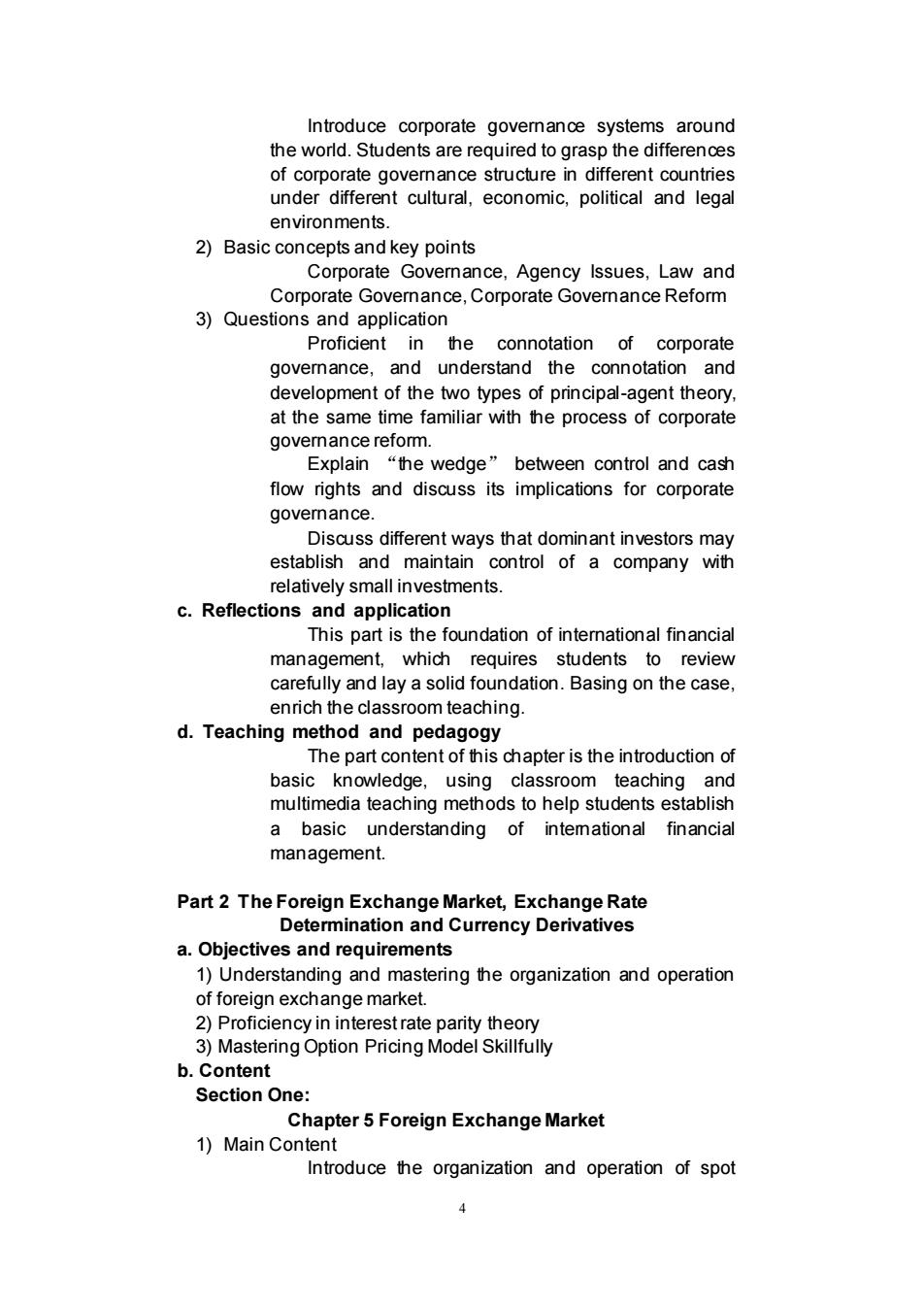
Introduce corporate govemnance systems around the world.Students are required to of corporate gover e structure in different countries under different cultural,economic,political and legal environments. 2)Basic concepts and key points Corporate Govemance,Agency Issues,Law and Corporate Gove Corporate ce Reform 3)Questions and atior Proficient in the connotation of corporate governance,and understand the connotation and development of the two types of principal-agent theory at the same time familiar with the process corporate govemanc Explain the wedge between control and cash flow rights and discuss its implications for corporate govemnance. Discuss diffe ent ways that dominant investors establish and maintain contro relatively small investments. c.Reflections and application This part is the foundation of intemational financial management,which requires students to review carefully and lay a solid fo tion.Basing or the case enrich the classroom teaching. d.Teaching method and pedagogy The part content of this chapter is the introduction of basic knowledge. multimedia teaching methods to help studer stablish a basic understanding of intemationa financial management. Part 2 The Foreign Exchange Market,Exchange Rate Determination and Currency Derivatives a.Objectives and requireme 1)Understanding and mastering the organization and operation of foreign exchange market. 2)Proficiency in interest rate parity theory 3)Mastering Option Pricing Model Skillfully b.Content Section One Chapter 5 Foreign Exchange Market 1)Main Content Introduce the organization and operation of spot
4 Introduce corporate governance systems around the world. Students are required to grasp the differences of corporate governance structure in different countries under different cultural, economic, political and legal environments. 2) Basic concepts and key points Corporate Governance, Agency Issues, Law and Corporate Governance, Corporate Governance Reform 3) Questions and application Proficient in the connotation of corporate governance, and understand the connotation and development of the two types of principal-agent theory, at the same time familiar with the process of corporate governance reform. Explain “the wedge” between control and cash flow rights and discuss its implications for corporate governance. Discuss different ways that dominant investors may establish and maintain control of a company with relatively small investments. c. Reflections and application This part is the foundation of international financial management, which requires students to review carefully and lay a solid foundation. Basing on the case, enrich the classroom teaching. d. Teaching method and pedagogy The part content of this chapter is the introduction of basic knowledge, using classroom teaching and multimedia teaching methods to help students establish a basic understanding of international financial management. Part 2 The Foreign Exchange Market, Exchange Rate Determination and Currency Derivatives a. Objectives and requirements 1) Understanding and mastering the organization and operation of foreign exchange market. 2) Proficiency in interest rate parity theory 3) Mastering Option Pricing Model Skillfully b. Content Section One: Chapter 5 Foreign Exchange Market 1) Main Content Introduce the organization and operation of spot
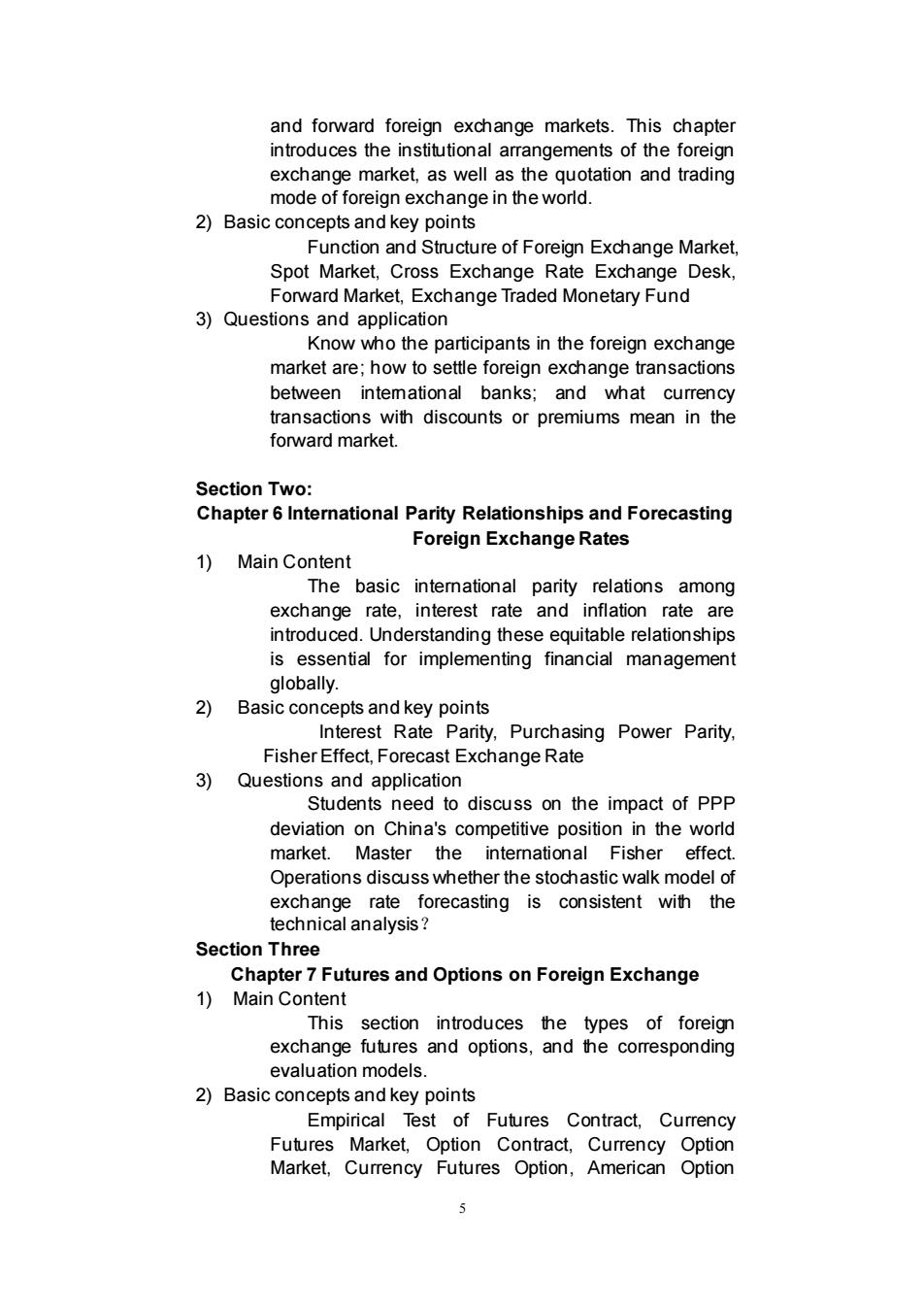
and forward foreign exchange markets.This chapter introduces the institutional foreign exchange market.as well as the quotation and trading mode of foreign exchange in the world. 2)Basic concepts and key points Function and Structure of Foreign Exchange Market Spot Market,Cross Exchange Rate Exo change Desk Forward Market,Exchange Traded Monetary Fund 3)Questions and application Know who the participants in the foreign exchange market are;how to settle foreign exchange transactions between intemational banks:and what currency transactions with discounts or premiums mean in the forward market Section Two: Chapter 6 International Parity Relationships and Forecasting Foreign Exchange Rates 1)Main Content The basic intemational parity relations among exchange rate,interest rate and inflation rate are introduced.Understanding these equitable relationships is essential for implementing financial management globally 2)Basic concepts and key points Interest Rate Parity,Purchasing Power Parity, Fisher Effect,Forecast Exchange Rate 3)Questions and application Students need to discuss on the impact of PPP deviation on China's competitivepositioninthe word market.Master the intemational Fisher effect Operations discuss whether the stochastic walk model of exchange rate forecasting is consistent with the technical analysis? Section Thre Chapter 7 Futures and Options on Foreign Exchange 1)Main Content This section introduces the types of foreigr exchange futures and options and the esponding evaluatio els 2)Basic concepts and key points Empirical Test of Futures Contract,Currency Futures Market,Option Contract,Currency Option Market,Currency Futures Option,American Option
5 and forward foreign exchange markets. This chapter introduces the institutional arrangements of the foreign exchange market, as well as the quotation and trading mode of foreign exchange in the world. 2) Basic concepts and key points Function and Structure of Foreign Exchange Market, Spot Market, Cross Exchange Rate Exchange Desk, Forward Market, Exchange Traded Monetary Fund 3) Questions and application Know who the participants in the foreign exchange market are; how to settle foreign exchange transactions between international banks; and what currency transactions with discounts or premiums mean in the forward market. Section Two: Chapter 6 International Parity Relationships and Forecasting Foreign Exchange Rates 1) Main Content The basic international parity relations among exchange rate, interest rate and inflation rate are introduced. Understanding these equitable relationships is essential for implementing financial management globally. 2) Basic concepts and key points Interest Rate Parity, Purchasing Power Parity, Fisher Effect, Forecast Exchange Rate 3) Questions and application Students need to discuss on the impact of PPP deviation on China's competitive position in the world market. Master the international Fisher effect. Operations discuss whether the stochastic walk model of exchange rate forecasting is consistent with the technical analysis? Section Three Chapter 7 Futures and Options on Foreign Exchange 1) Main Content This section introduces the types of foreign exchange futures and options, and the corresponding evaluation models. 2) Basic concepts and key points Empirical Test of Futures Contract, Currency Futures Market, Option Contract, Currency Option Market, Currency Futures Option, American Option
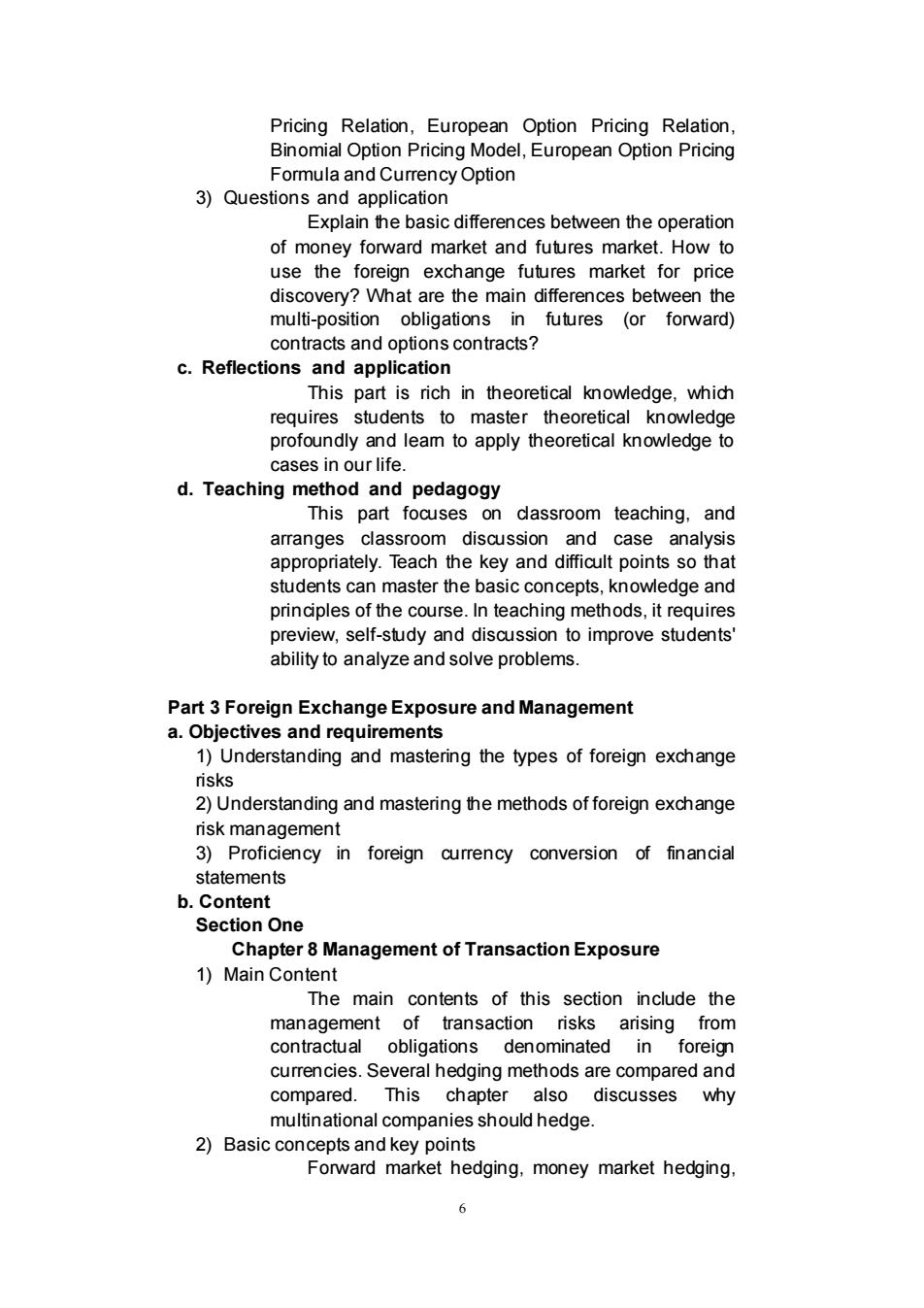
Pricing Relation,European Option Pricing Relation Binom nial Option Pricing Model,European Option Pricing Formula and Currency Option 3)Questions and application Explain the basic differences between the operation of money forward market and futures market.How to use the foreign exchange futures market for price overy?What ar e the main ere nces bet een the multi-position obligation forward) contracts and options contracts? c.Reflections and application This part is rich in theoretical knowledge,which requ ma theoret ical knowledge profoundly and leam to apply theoretic cases in our life d.Teaching method and pedagogy This part focuses on dassroom teaching.and arranges discussio case approp iately.Teach the key and difficult poin so tha students can master the basic concepts,knowledge and principles of the course.In teaching methods,it requires preview,self-study and discussion to improve students' ability to analyze and solve problems. Part 3 Foreign Exchange Exposure and Management a.Objectives and requirements 1)Understanding and mastering the types of foreign exchange risks 2)Understanding and mastering the methods of foreign exchange risk nagement 3)Proficiency in foreign currency conversion of financial statements b.Content Section One Ch apter 8 Management of Transaction Exposure 1)Main Content The main contents of this section include the management of transaction risks arising from contractual obligations denominated in foreign cumencies.Several hedging m nethods are co mpared compared. This cnapte also discusses why multinational companies should hedge. 2)Basic concepts and key points Forward market hedging,money market hedging, 6
6 Pricing Relation, European Option Pricing Relation, Binomial Option Pricing Model, European Option Pricing Formula and Currency Option 3) Questions and application Explain the basic differences between the operation of money forward market and futures market. How to use the foreign exchange futures market for price discovery? What are the main differences between the multi-position obligations in futures (or forward) contracts and options contracts? c. Reflections and application This part is rich in theoretical knowledge, which requires students to master theoretical knowledge profoundly and learn to apply theoretical knowledge to cases in our life. d. Teaching method and pedagogy This part focuses on classroom teaching, and arranges classroom discussion and case analysis appropriately. Teach the key and difficult points so that students can master the basic concepts, knowledge and principles of the course. In teaching methods, it requires preview, self-study and discussion to improve students' ability to analyze and solve problems. Part 3 Foreign Exchange Exposure and Management a. Objectives and requirements 1) Understanding and mastering the types of foreign exchange risks 2) Understanding and mastering the methods of foreign exchange risk management 3) Proficiency in foreign currency conversion of financial statements b. Content Section One Chapter 8 Management of Transaction Exposure 1) Main Content The main contents of this section include the management of transaction risks arising from contractual obligations denominated in foreign currencies. Several hedging methods are compared and compared. This chapter also discusses why multinational companies should hedge. 2) Basic concepts and key points Forward market hedging, money market hedging
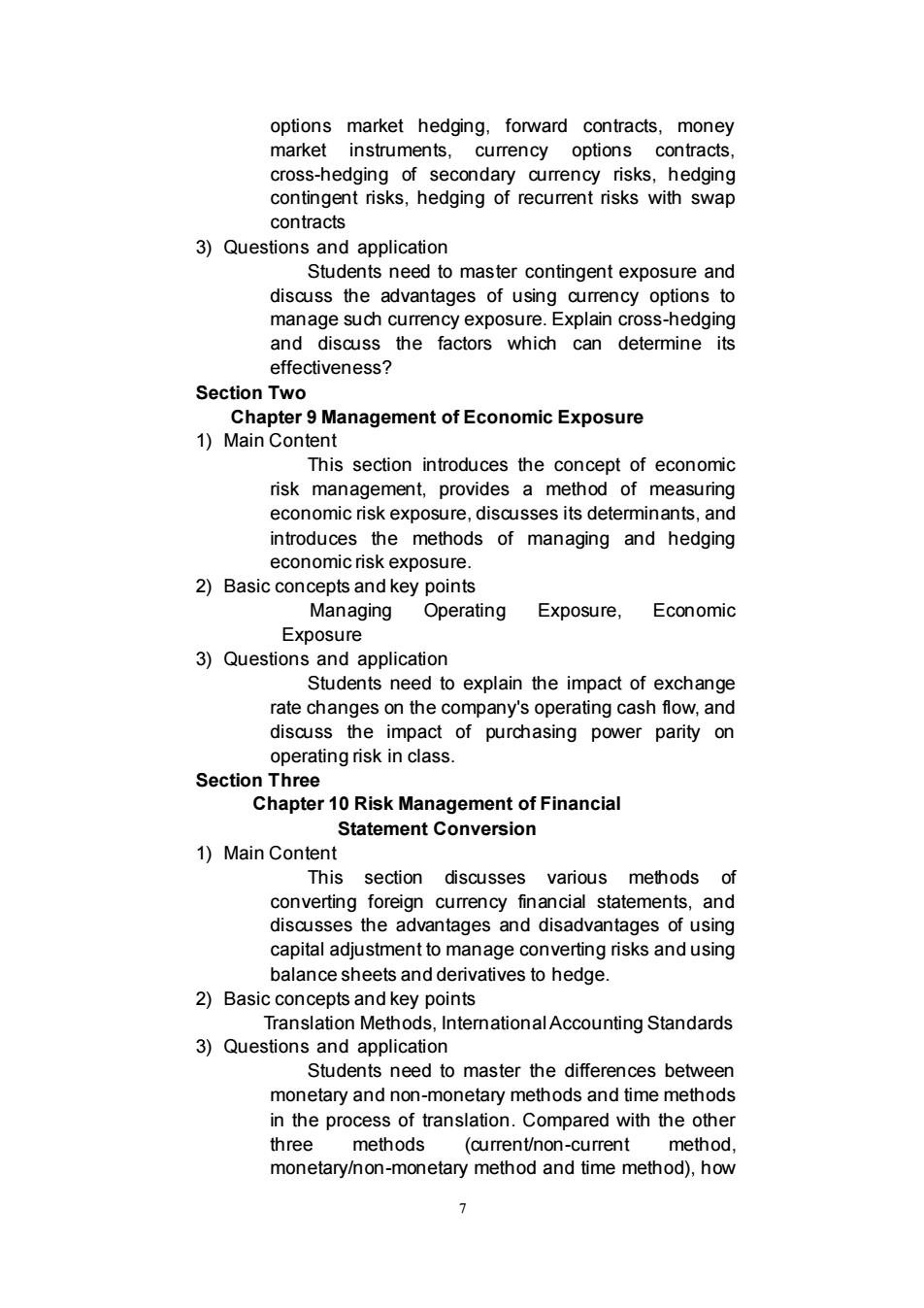
options market hedging,forward contracts,money market nstru currency options contracts cross-heding osecondary cumrencys contingent risks,hedging of recurrent risks with swap contracts 3)Questions and application S s eed to master contingent exposure and discuss the advantages of using currency options to manage such currency exposure.Explain cross-hedging and discuss the factors which can determine its effectiveness? Section Two apter 9 Management of Economic Exposure 1)Main Content This section introduces the concept of economic risk management,provides a method of measuring economic risk exposure,discusses its determinants,and introdu the m thods of managing and hedging economic risk exposure 2)Basic concepts and key points Managing Operating Exposure,Economic Exnosure )stiexpi the impact of exchan rate changes on the company's operating cash flow,and discuss the impact of purchasing power parity on operating risk in class. Section Three Chapter 10 Risk Management of Financial Statement Conversion 1)Main Content This section discusses various methods of converting foreign currency financial statements,and discusses the advantages and disadvanta es of usino capital adjustment to manage converting risks and using balance sheets and dervatives to hedge. 2)Basic concepts and key points Translation methods.Internationalaccounting standards 3)Questions and application Stu need to master the differences betweer monetary and non-monetary methods and time methods in the process of translation.Compared with the other three methods (current/non-current method. monetary/non-monetary method and time method),how
7 options market hedging, forward contracts, money market instruments, currency options contracts, cross-hedging of secondary currency risks, hedging contingent risks, hedging of recurrent risks with swap contracts 3) Questions and application Students need to master contingent exposure and discuss the advantages of using currency options to manage such currency exposure. Explain cross-hedging and discuss the factors which can determine its effectiveness? Section Two Chapter 9 Management of Economic Exposure 1) Main Content This section introduces the concept of economic risk management, provides a method of measuring economic risk exposure, discusses its determinants, and introduces the methods of managing and hedging economic risk exposure. 2) Basic concepts and key points Managing Operating Exposure, Economic Exposure 3) Questions and application Students need to explain the impact of exchange rate changes on the company's operating cash flow, and discuss the impact of purchasing power parity on operating risk in class. Section Three Chapter 10 Risk Management of Financial Statement Conversion 1) Main Content This section discusses various methods of converting foreign currency financial statements, and discusses the advantages and disadvantages of using capital adjustment to manage converting risks and using balance sheets and derivatives to hedge. 2) Basic concepts and key points Translation Methods, International Accounting Standards 3) Questions and application Students need to master the differences between monetary and non-monetary methods and time methods in the process of translation. Compared with the other three methods (current/non-current method, monetary/non-monetary method and time method), how

to deal with the conversion gains and losses according to the current exchange rate me thod? c.Reflections and appl This part is rich in theoretical knowledge,which requires students to master theoretical knowledge profoundly and leam to apply theoretical knowledge to practical pricing cases. d.Teaching method a pedagogy part focuses on classroom teaching,and arranges classroom discussion and case analysis appropriately.Teach the key and difficult points so that students can master the basic concepts,knowledge and iples of the In ning 005 it req ires preview,s study and discus on to improve student ability to analyze and solve problems. Part 4 World Financial Markets and Institutions a.Objectives and requireme nts rstanding International Banks and Intemational Money Marke 2)Understanding and mastering the international bond and stock markets 3)Understanding and mastering intemational options market and b.Content Section One: Chapter 11 International Banking and Money Market 1)Main Content This section discusses why MNCs make capital expenditu res in productive capacity in foreign lands rather than just producing domestically and then exporting to overseas markets. 2)Basic concepts and key points Intemational Banking Services Reasons for Intemational Banking,Types of Intemational Banking Offices, Capital Adequacy Standards,Intemationa Money Market,Intemational Debt Crisis,The Asian Crisis,Global Financial Crisis 3)Questions and application Stude te eed to leam how to apply he knowledge of this chapter to practice.Classroom discussions wil focus on the weaknesses of the New Basel Accord in the global financial crisis that began in mid-2007,and on the requlatory and macroeconomic factors that led to the
8 to deal with the conversion gains and losses according to the current exchange rate method? c. Reflections and application This part is rich in theoretical knowledge, which requires students to master theoretical knowledge profoundly and learn to apply theoretical knowledge to practical pricing cases. d. Teaching method and pedagogy This part focuses on classroom teaching, and arranges classroom discussion and case analysis appropriately. Teach the key and difficult points so that students can master the basic concepts, knowledge and principles of the course. In teaching methods, it requires preview, self-study and discussion to improve students' ability to analyze and solve problems. Part 4 World Financial Markets and Institutions a. Objectives and requirements 1) Understanding International Banks and International Money Market 2) Understanding and mastering the international bond and stock markets 3) Understanding and mastering international options market and international portfolio b. Content Section One: Chapter 11 International Banking and Money Market 1) Main Content This section discusses why MNCs make capital expenditures in productive capacity in foreign lands rather than just producing domestically and then exporting to overseas markets. 2) Basic concepts and key points International Banking Services, Reasons for International Banking, Types of International Banking Offices, Capital Adequacy Standards, International Money Market, International Debt Crisis, The Asian Crisis, Global Financial Crisis 3) Questions and application Students need to learn how to apply the knowledge of this chapter to practice. Classroom discussions will focus on the weaknesses of the New Basel Accord in the global financial crisis that began in mid-2007, and on the regulatory and macroeconomic factors that led to the

credit crunch in 2007-2008.The Impact of Structural ent Inst rume on on Credit Crisis;Credit Default Swap on Credit Crisis Section Two Chapter 12 International Bond Market 1)Main Content This secion deals with the intemational capital structure and the cost of capital of a INC n analytic argument is presented showing that the firm's cost o capital is lower when its shares trade intemationally and if debt capital is sourced intemationally. 2)Basic conce Euro bonds,Intemational Bond Market Credit Ratings. Euro bond Market Structure and Practices.Intem ational Bond Market Index 3)Questions and application Grasp e between foreign bonds and Briefly define each of the main types o instruments in the intemational bond market,and pay attention to their distinctive characteristics.Why is Moody's or Standard &:Poor's credit rating high for most interational debt?What factors did Standar assigned to sovereign governments? Section Three Chapter 13 International Equity Market 1)Main Content This section presents the adjusted present value (APV)framework of Donald Lessard that is useful for the parent fimm in analyzing a capital expenditure in foreigr operations. 2)Basic concer heCapital Budetng Anaysis Sensitivity Analysis. Purchasing Power Parity Assumption Real options 3)Questions and application Why is capital budgeting analysis so important to the firm?What is the in the NPV capital budgeting framework?Discuss what is meant by the incremental cash flows of a capital project.What makes the APV capital budgeting framework useful for analyzing foreign capital expenditures?
9 credit crunch in 2007-2008. The Impact of Structural Investment Instruments on Credit Crisis; Mortgage Debt on Credit Crisis; Credit Default Swap on Credit Crisis Section Two Chapter 12 International Bond Market 1) Main Content This section deals with the international capital structure and the cost of capital of a MNC. An analytical argument is presented showing that the firm’s cost of capital is lower when its shares trade internationally and if debt capital is sourced internationally. 2) Basic concepts and key points The World’s Bond Markets, Foreign Bonds and Euro bonds, International Bond Market Credit Ratings, Euro bond Market Structure and Practices, International Bond Market Index 3) Questions and application Grasp the difference between foreign bonds and European bonds. Briefly define each of the main types of instruments in the international bond market, and pay attention to their distinctive characteristics. Why is Moody's or Standard & Poor's credit rating high for most international debt? What factors did Standard & Poor's analyze in determining the credit ratings it assigned to sovereign governments? Section Three Chapter 13 International Equity Market 1) Main Content This section presents the adjusted present value (APV) framework of Donald Lessard that is useful for the parent firm in analyzing a capital expenditure in foreign operations. 2) Basic concepts and key points Risk Adjustment in the Capital Budgeting Analysis, Sensitivity Analysis, Purchasing Power Parity Assumption, Real Options 3) Questions and application Why is capital budgeting analysis so important to the firm? What is the intuition behind the NPV capital budgeting framework? Discuss what is meant by the incremental cash flows of a capital project. What makes the APV capital budgeting framework useful for analyzing foreign capital expenditures?

Section Four Chapter 14 Interest Rate and Currency Swaps 1)Main Content This section covers issues in cash management for the MNC.The section shows that if a MNC establishes a centralized cash depository and a multilateral system. the number of foreign cash flow transactions can be d saving it its cash. t money and giving it better contro 2)Basic concepts and key points Types of Swaps,Size of the Swap Market,The Swap Bank Swap Market ouotations Interest Rate ncy Sw aps. Va s of Basic Interest f Interes Rate Currency Swaps 3)Questions and application Master the difference between a swap broker and a Vha eces nsmpci for comparative advantage theory and currency swap market?Discuss the risks faced by interest rate and currency swap traders.Some changes in basic interest rates and currency swaps are briefly discussed. Section Five Chapter 15 International Portfolio Investment 1)Main Content This section provides a brief introduction to trade financing and counter trade.An example of a typical foreign trade transaction explains the three pri documents tha t are used in trade financing:letter o credit,time draft,and bill of lading. 2)Basic concepts and key points International Correlation Structure and Risk Diversification, Optimal Intemational Portfolio Selection, Effects of Changes in the Excha ange Rate Intemational Bond Investment. Mutua Funds,International Diversification with Small-Cap 3)Questions and application Master the concept of sharp Performance Measurement;Explain ow excha rate flu affect the retum of foreign markets measured in US dollars;Explore the empirical evidence of the impact of exchange rate uncertainty on foreign investment risk Whether exchange rate fluctuations increase the risk of
10 Section Four Chapter 14 Interest Rate and Currency Swaps 1) Main Content This section covers issues in cash management for the MNC. The section shows that if a MNC establishes a centralized cash depository and a multilateral system, the number of foreign cash flow transactions can be reduced, saving it money and giving it better control of its cash. 2) Basic concepts and key points Types of Swaps, Size of the Swap Market, The Swap Bank, Swap Market Quotations, Interest Rate Swaps, Currency Swaps, Variations of Basic Interest Rate and Currency Swaps, Risks of Interest Rate and Currency Swaps 3) Questions and application Master the difference between a swap broker and a swap trader. What are the necessary conditions for floating rate swaps? What is the relationship between comparative advantage theory and currency swap market? Discuss the risks faced by interest rate and currency swap traders. Some changes in basic interest rates and currency swaps are briefly discussed. Section Five Chapter 15 International Portfolio Investment 1) Main Content This section provides a brief introduction to trade financing and counter trade. An example of a typical foreign trade transaction explains the three primary documents that are used in trade financing: letter of credit,time draft, and bill of lading. 2) Basic concepts and key points International Correlation Structure and Risk Diversification , Optimal International Portfolio Selection, Effects of Changes in the Exchange Rate, International Bond Investment , International Mutual Funds, International Diversification with Small-Cap 3) Questions and application Master the concept of Sharp Performance Measurement; Explain how exchange rate fluctuations affect the return of foreign markets measured in US dollars; Explore the empirical evidence of the impact of exchange rate uncertainty on foreign investment risk; Whether exchange rate fluctuations increase the risk of